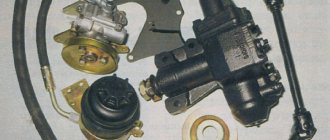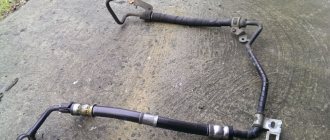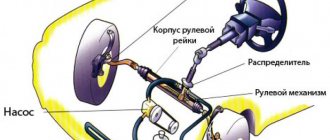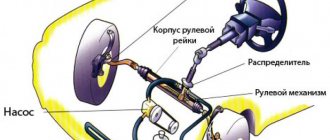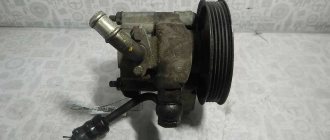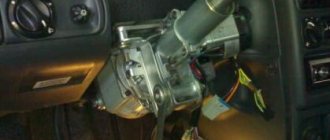Dexron 2 and 3 fluids , which are used in power steering and automatic transmissions, lie in their fluidity rates, type of base oil, and temperature characteristics. In general terms, we can say that Dextron 2 is an older product released by General Motors, and accordingly, Dextron 3 is a newer one. However, you cannot simply replace the old fluid with a new one. This can only be done by observing the manufacturer’s tolerances, as well as the characteristics of the liquids themselves.
Divinol ATF Dexron II D. Dextron 2 for automatic transmission
Repair of automatic transmissions of any complexity
CVTs, DSG, torque converters, new and reconditioned automatic transmissions, spare parts
We operate in more than 30 cities
- home
- About us About the company
- our team
- Communication with management
- Diplomas and certificates
- Network of branches and partners
- Reviews from our clients
- Automatic transmission diagnostics
- Determination of automatic transmission type
- Spare parts for automatic transmission
- Links
- Unanswered messages
- Active topics
- Search
- our team
- List of forumsConference for those who “break” automatic transmissionsGeneral questions about automatic transmissions
- Search
- Unanswered messages
- Active topics
- Links
- Unanswered messages
- Active topics
- Search
- our team
- List of forumsConference for those who “break” automatic transmissionsGeneral questions about automatic transmissions
- Search
- Unanswered messages
- Active topics
Types and types of Dexron liquids
Let's start with the fact that today you can find fluids ranging from Dexron 2, Dexron IID or Dexron 3 to Dexron 6. In fact, each type is a separate generation of transmission fluid, widely known as Dexron. The development belongs to the concern General Motors (GM), which in 1968 created its own transmission fluid for automatic transmissions, Dexron.
- Let's return to Dextron. After the first generation of such fluids entered the market, just 4 years later GM was forced to develop the second generation of Dextron.
The reason is that the first generation actively used whale oil as a friction modifier, and the transmission oil itself on this basis quickly became unusable due to high heat in the automatic transmission. A new formula was supposed to solve the problems, which became the basis of Dexron IIC.
In fact, whale oil was replaced with jojoba oil as a friction modifier, and the product's heat resistance was also improved. However, with all the advantages, the composition had one serious drawback - severe corrosion of automatic transmission elements.
For this reason, they quickly stopped using Dexron IID, releasing the product Dexron IIE, filled with active additives that work against moisture and corrosion. It is noteworthy that this generation of liquid has become semi-synthetic.
Moreover, having convinced itself of its effectiveness, after a short period of time the concern released a fundamentally new liquid with improved performance characteristics. First of all, while earlier generations were mineral or semi-synthetic based, the new Dexron 3 ATF was made from a synthetic base.
This solution turned out to be resistant to high heat, had excellent lubricating and protective properties, and remained fluid at low temperatures (up to -30 degrees Celsius). It was the third generation that became truly universal and began to be widely used in automatic transmissions, power steering, etc.
- Today, the latest generation is Dexron VI (Dextron 6), developed for the six-speed Hydra-Matic 6L80 automatic transmission. The product has improved lubricating properties, reduced kinematic viscosity, resistance to foaming and corrosion.
Moreover, the manufacturer positions such a liquid as a composition that does not require replacement. In other words, such oil is poured into the automatic transmission for the entire service life of the unit.
- Please note that different manufacturers began to produce automatic transmission fluids quite a long time ago, and the products are produced under the Dexron brand. As for GM, the concern has been producing only this type of fluid since 2006, while other oil manufacturers continue to produce Dextron IID, IIE, III, etc.
As for GM, the corporation is not responsible in any way for the quality and properties of fluids of previous generations, although they continue to be produced according to the Dexron standard. It can also be noted that today Dexron fluids can be standard or HP (high performance) for automatic transmissions that operate in difficult conditions.
There are also Dexron Gear Oils for differentials and clutches, Dexron Manual Transmission Fluid for manual transmissions, Dexron Dual Clutch Transmission Fluid for dual-clutch robotic gearboxes, Dextron for power steering, as well as other units and mechanisms. There is information that General Motors is testing the latest generation of fluid for use as a transmission oil for CVTs.
Generations of Dexron liquids and their characteristics
To understand what are the differences between Dexron II and Dexron III, as well as what is the difference in one and the other transmission fluid, it is necessary to briefly look at the history of their creation, as well as the characteristics that have changed from generation to generation.
Dexron II characteristics
This transmission fluid was first released by General Motors in 1973. Its first generation was called Dexron 2 or II C. It was based on mineral oil from the second group according to the API classification - American Petroleum Institute. In accordance with this standard, the base oils of the second group were obtained by using hydrocracking. In addition, they contain at least 90% saturated hydrocarbons, less than 0.03% sulfur, and also have a viscosity index ranging from 80 to 120.
Viscosity index is a relative value that characterizes the degree of change in oil viscosity depending on temperature in degrees Celsius, and also determines the flatness of the kinematic viscosity curve versus ambient temperature.
The first additives that began to be added to transmission fluid were corrosion inhibitors. In accordance with the license and designation (Dexron IIC), the composition on the packaging is designated starting with the letter C, for example, C-20109. The manufacturer indicated that it is necessary to change the fluid to a new one every 80 thousand kilometers. However, in practice it turned out that corrosion occurs much faster, so General Motors began producing the next generation of its products.
So, in 1975, transmission fluid Dexron-II (D) . It was made on the same base mineral oil of the second group , but with an improved complex of anti-corrosion additives, in particular, preventing corrosion of the joints of oil coolers of automatic transmissions. This liquid had a fairly high minimum permissible operating temperature - only -15°C. But since the viscosity remained at a fairly high level, due to the improvement of transmission systems, this began to lead to vibrations when driving some models of new cars.
Beginning in 1988, automakers began replacing automatic transmissions with hydraulic control systems with electronic ones. Accordingly, they needed a different lubricant for automatic transmissions, one with low viscosity, which provides a much higher rate of force transmission (response) due to better fluidity.
In 1990, Dexron-II (E) (the specification was revised in August 1992, re-release began in 1993). His base was the same - the second API group. However, due to the use of a more modern additive package, gear oil is now considered synthetic! The lowest temperature for this liquid was reduced and became -30°C. Improved performance is the key to smooth automatic transmission gear shifting and increased service life. The license designation begins with the letter E, for example E-20001.
Dexron III characteristics
For Dextron 3 transmission fluids, the base oils belong to group 2+ , which is characterized by increased class 2 characteristics; in particular, the hydrotreating method is used in production. The viscosity index here is increased , and its minimum value ranges from 110...115 units and above . That is, Dexron 3 has a completely synthetic base .
The first generation was Dexron-III (F) . In fact, this is just an improved version of Dexron-II (E) with the same temperature ratings of -30°C. The disadvantages include low durability and poor shear stability, and fluid oxidation. This composition is designated with the letter F at the beginning, for example, F-30001.
The second generation - Dexron-III (G) , appeared in 1998. The improved composition of this fluid has completely overcome the problems of vibration when the car is moving. The manufacturer also recommended it for use in hydraulic power steering (power steering), some hydraulic systems, as well as in rotary air compressors where a high level of fluidity at low temperatures is required.
The minimum operating temperature at which Dextron 3 liquid can be used has become -40°C . This composition began to be designated with the letter G, for example, G-30001.
Third generation - Dexron III (H) . It was released in 2003. This fluid has a synthetic base and an even more improved additive package. Thus, the manufacturer claims that it can be used as a universal lubricant for all automatic transmissions with and without a controlled torque converter lock-up clutch, that is, the so-called GKÜB for gear shift lock-up. It has a very low viscosity in cold weather, so it can be used down to -40°C.
Application area
ATF Dextron was originally developed for automatic transmissions. Oil in an automatic transmission performs different functions: transmits torque, creates pressure on the clutches and guarantees proper friction, lubricates parts, protects against corrosion, and removes heat. When choosing ATP, you need to check the product for the Dextron specification.
Dextron specifications indicate the optimal viscosity index for each type of ATP. High viscosity oils increase the slippage of friction discs and increase wear on the rubbing parts of automatic transmissions. With low viscosity, the protective film on bearings and gears is thin and breaks quickly. Bullies appear. The seals are deformed. Automatic transmission fluid is leaking.
The operating viscosity of ATF Dexron III H is in the range of 7 - 7.5 cSt at 100℃. This indicator guarantees that Dextron 3 oil in automatic transmissions will last a long time without replacement, maintaining its performance properties.
ATF Dexron III H is used in 4 and 5-speed automatic transmissions manufactured before 2006. The boxes are installed in cars, commercial vehicles, and buses.
With the expansion of the functionality of the transmission fluid, the scope of application has also increased:
- hydraulic systems: power steering, hydrostatic transmission, hydraulic drive, hydropneumatic suspension, hydraulic brake system;
- gearboxes for construction, agricultural and mining equipment;
- industrial equipment.
The requirements for power steering oil are similar to those of automatic transmissions, so Opel, Toyota, Kia, Geely allow the use of ATF Dexron in the hydraulic booster. BMW, VAG, Renault, Ford recommend pouring a special power steering fluid - PSF, CHF.
The use of ATP Dextron is divided into climatic zones:
- for regions with winter temperatures down to -15℃, Dextron II D is suitable;
- with temperatures up to -30℃ - Dextron II E;
- with temperatures up to -40℃ - Dextron III H.
Characteristics of Dexron 2 and 3 oils for power steering, is it possible to pour and mix?
Hydraulic power steering is designed to make steering easier, as well as dampen vibrations and shocks that occur on the steering wheel. In order for it to last a long time and work stably, it is necessary to regularly change the oil in it and monitor its quality. The article discusses Dextron oils, including Dextron 3 for power steering, and gives their description, advantages and disadvantages.
Description of the liquid
The power steering design consists of several mechanisms, which are visible in the diagram.
Power steering diagram for cars
The entire mechanism is washed by a special hydraulic fluid (PSF).
It has the following functions:
- transmits pressure from the pump to the piston;
- has a lubricating effect;
- has anti-corrosion properties;
- cools the components and mechanisms of the unit.
Popular brands specifications
Mannol Dexron 3
Mannol Dexron 3 automatic is considered a multi-purpose oil for automatic transmissions. This Manol mixture is also used in power steering, hydraulic clutches, and spinning mechanisms.
Just like all, without exception, Dextron oils have a reddish tone. The manufacturer has worked hard on the combination of additives and synthetic components, the components of which help improve the fractional characteristics at the time of gear shifting.
Oil from a manufacturer in Germany has high low-temperature characteristics, excellent antioxidant properties, and stable chemical composition throughout the entire period of operation. It is not advisable to use copper elements as a lubricant; the liquid is absolutely neutral to all other alloys and materials.
The products have all possible tolerances:
- ZF-TE-ML 09/11/14, ALLISON C4/TES 389, GM DEXR. III H/G/F, FORD M2C138-CJ/M2C166-H and others.
Castrol DEXRON
Castrol DEXRON is a low-viscosity mixture for automatic transmissions and is designed for use in modern gearboxes. It has proven itself to be the mixture with the greatest fuel economy.
Castrol production is established in Germany. The oil consists of high-quality base mixtures with an optimal set of additives. Has positive feedback from GM and Ford management, exceeds the requirements of the Japanese JASA 1A specification. In cases where it is not possible to purchase Dextron ATF for the Japanese, you can safely use oil from Castrol - Dexron 6.
Meets all major standards:
- Honda/Acura, Hyundai/Kia SP, Nissan Matic, Suzuki AT Oil, Mitsubishi SP, Mazda ATF, Toyota and Subaru.
Mobil 3 ATF oil
Mobil ATF 320 Premium oil has a mineral structure. Used in power steering and automatic transmissions with GM Dexron 3 approval standard.
Mobil absolutely complies with all types of transmission seals in automatic transmission mechanisms. Compatible with all red liquids of the Dexron III specification. The composition is not recommended for use on northern continents, where temperatures drop to -30 degrees. Mobil oil with Dextron No. 3 specification can also be used in power steering mechanisms.
Meets Ford Mercon, ATF Dex standards. III, ZF TE-ML and Dex. 3
Motul Multi ATF
Motul Multi ATF is 100% synthetic fluid. A universal oil designed for automatic transmissions manufactured since 2000.
It is also possible to use it in hydrostatic transmissions, power steering, and other mechanisms (including ATF) that support standard Mercon and Dexron. Motul occupies a leading position in chemical composition and viscosity, temperature performance, stability functions, and meets all requirements from GM.
It is not recommended for use in hydraulic power steering automatic transmissions, since the fluid was created specifically for automatic transmissions. Has many approvals and positive reviews.
It has proven itself as a reliable gear oil. The only drawback of the Motul Multi premium mixture is its price.
Meets the basic standards of MAZDA, CHRYSLER, JAGUAR, RENAULT Elfmatic, Renaultmatic D2 D3, Acura/HONDA, Lexus/TOYOTA ATF, Audi, GM DEXRON 2 and 3, FORD, BMW and MITSUBISHI.
Description of the liquid
The power steering design consists of several mechanisms, which are visible in the diagram.
Power steering diagram for cars
The entire mechanism is washed by a special hydraulic fluid (PSF).
It has the following functions:
- transmits pressure from the pump to the piston;
- has a lubricating effect;
- has anti-corrosion properties;
- cools the components and mechanisms of the unit.
Thanks to the power steering oil, which circulates in a closed circuit, the created pressure is transferred from the pump to other components of the unit. When high pressure is created in the pump, PSF enters the low pressure zone where the SGC pistons are located. The cylinder is connected to the steering wheel rack using a spool. Depending on the position of the steering wheel, the spool directs oil, making it easier to turn the steering wheel.
An important function of PSF is to remove excess heat from mechanisms. In addition, acting as a lubricant, it reduces friction between moving components. Anti-corrosion additives in the composition prevent rust from forming inside the mechanism.
Compound
PSFs are divided into three types:
- mineral;
- semi-synthetic;
- synthetic.
Mineral ones contain 97% naphthenes and paraffins, the rest are additives that impart certain properties. Semi-synthetics contain both mineral and synthetic components. They have a longer service life and better performance. Synthetic PSF contains polyesters, hydrocracked petroleum fractions, and polyhydric alcohols. In addition, they contain additives that improve its properties.
PSF contains the following additives:
- to reduce friction between parts;
- against corrosion processes;
- viscosity stabilizing;
- acidity stabilizing;
- giving color;
- preventing foaming;
- to protect rubber parts.
When choosing power steering oil, you should pay attention to the composition and technical characteristics (video author - Vladislav Chikov).
Advantages and disadvantages
Each type of working fluid has its own advantages and disadvantages:
| Type PSF | Advantages | Flaws |
| Mineral |
| |
| Semi-synthetic |
| |
| Synthetic |
|
Dextron red
Interchangeability and miscibility
The manufacturer introduced the qualification of power steering fluids by color by adding coloring pigments to their composition: red, yellow and green. Red power steering oils are developed according to General Motors standards; they are called Dextrons.
Advantages and disadvantages
Eneos ATF DEXRON-II lubricant has its positive and negative sides. Benefits include:
- protection of the transmission from friction and rapid wear;
- fuel efficiency improves;
- vibration in the engine and gearbox is reduced;
- improved viscosity characteristics, promote rapid pumping and lubrication of parts; see;
- with the help of additives and impurities, characteristics such as anti-corrosion, anti-foaming and stability have been achieved;
- the gear engages better and the clutches work softer;
- excellent fluidity at low temperatures.
What kind of oil is poured into the power steering?
The choice of oil for power steering should first of all be carried out in accordance with the recommendations of the vehicle manufacturer. If there is no opportunity or desire to follow the instructions, then ATF in the middle price category can be a universal option.
However, there is a small nuance here. Synthetics or semi-synthetics will cost more than mineral water, however, they have more stable viscosity values. This is especially important if the car is operated at low temperatures. Oil that is thinner in cold weather will ensure minimal wear on the pump when the power steering is operating on a cold vehicle, which ultimately minimizes the likelihood of its failure. Therefore, many drivers, despite the price, prefer to fill the power steering with a more expensive synthetic type of oil.
In turn, experts recommend taking into account the following factors when choosing the optimal power steering fluid:
- Hydraulic oil must withstand not only low, but also high temperatures, since in summer it can heat up to +100 °C and higher.
- The liquid must have high fluidity, otherwise the pump will be subject to excessive loads, which will lead to premature wear and failure.
Among other things, the oil must have a good working life, since it is usually replaced no more than once every 2-3 years or after 70-90 thousand kilometers.
Is it possible to mix oils?
During the operation of the vehicle, a variety of situations may arise that require urgent addition of fluid to the power steering. In such cases, many motorists ask a completely logical question: is it possible to mix oils? Professional service stations strongly advise against engaging in such experiments; however, car manufacturers themselves allow the possibility of mixing PSF, albeit with minor restrictions.
- The main rule that must be observed when resolving this issue is that in no case should mineral and synthetic compounds be poured into the hydraulic boosting system at the same time, since they have bases that are incompatible with each other.
- Red and yellow liquids can be mixed, since their chemical composition is largely similar to each other. The main thing is that the additives contained in the oil do not react with other substances and do not form unwanted compounds.
- Green oils should not be mixed with other liquids, as they contain synthetic and mineral components.
Is it possible to fill the power steering with engine oil?
In an attempt to save money, some vehicle owners, instead of using special PSF compounds intended for filling into power steering, prefer to use the remaining engine oil they have. In fact, this is only allowed if there is no other way out and the driver plans to correct the situation as soon as possible.
It is not worth using compounds that were developed for the engine for power steering, because these fluids perform different functions. Thus, power steering fluid must successfully cope with the following tasks:
- Lubrication of all components and mechanisms of the hydraulic booster system;
- Protection of power steering parts and components from corrosion and premature wear;
- Prevents excessive foaming;
- Cooling the amplification system in the hot season.
Obviously, engine oil performs slightly different functions, therefore, it would be a stretch to call these fluids interchangeable. At the same time, the base of motor oil, automatic transmission fluids and power steering compounds are no different from each other. They also contain similar additives aimed at reducing friction between metal, rubber and fluoroplastic parts. Therefore, if necessary, you can still fill the power steering with another fluid. But here everything is not so simple. For example, Europeans use exclusively special PSF, while the Japanese see nothing wrong with pouring ATF oil not only into the hydraulic booster, but also into the automatic transmission.
How much oil is in power steering
When completely replacing the fluid, the hydraulic booster system of a passenger car includes about 1 liter, while for trucks it will require 3-4 liters. When purchasing a composition, you must be guided by the volume specified by the machine manufacturer, purchasing technical fluids with a small reserve in case of emergency topping up.
How to check the level
It is noteworthy that not all drivers know where to look for the power steering reservoir. There is practically nothing complicated here, since it is usually located directly on the power steering pump housing, in the engine department. A low oil level in the power steering can lead to problems in the system, which will immediately appear on the dashboard. To check the fluid level, the car must be placed on a level, horizontal check. In general, there are two main ways to obtain the information you need:
- According to the marks applied to the walls of the power steering reservoir;
- According to the marks on the dipstick, which is built into the expansion tank.
On most modern cars and trucks, the following marks are applied to the power steering reservoir:
- Hot min and Hot max - allow you to control the minimum and maximum level of hot oil;
- Cold min and Cold max - show the minimum and maximum value of the cold liquid level.
Accordingly, when the engine is warm, you should look at the hot marks, and when the engine is cold, look at the cold marks. The best option would be to have the power steering fluid somewhere in the middle between min and max. If, even under one of the engine conditions (cold or warm), the level indicators are below or above the permissible values, it means that there is a malfunction of the power steering pump. For example, the causes of liquid leakage can be: depressurization of the system, mechanical damage to the tank or a malfunction of the valve on its lid, clogged filters, etc.
When checking the oil level in the power steering, it is worth spending a few minutes of your time to study the quality of the fluid. To do this, use a dipstick to take a small amount of lubricant and apply it to a clean sheet of white paper. The transparent composition and persistent color indicate that there is no cause for concern. But, if the oil is cloudy, foreign impurities are clearly visible in it, it should be replaced as quickly as possible, otherwise the power steering system may fail in the very near future. Sediment at the bottom of the expansion tank indicates that the additives have ceased to cope with the functions assigned to them and have begun to disintegrate into their constituent components.
How to understand that this is a fake ZIC ATF
Automatic gearbox oil ZIC ATF Dexron 6 is widely known to car enthusiasts, and therefore can be counterfeited quite often.
In order to understand whether this oil is original or not, you need to pay attention to the following distinctive features of ZIC ATF Dexron 6:
- There is a protective film on the very neck of the canister. It should fit snugly against the canister itself.
- Inside the canister lid there are numerous “ZIC” inscriptions on the protective foil.
- There must be a measuring scale on the side of the canister, which shows how much liquid is left in the container.
- The embossed label with the inscription and the canister itself must be made of red plastic.
- If you turn the package over, there should be a ZIC factory stamp on the bottom of the canister.
- Presence of a hologram on the packaging.
- When purchasing this oil, be sure to include documentation from the manufacturer (such as instructions, etc.).
Automatic transmission oils (ATF), when filled into the power steering, have the same functions as power steering fluids, the function of increasing the static friction of the clutches (depending on the material of the clutches) and the function of reducing friction wear.
Rating of ATF fluids for power steering 2022 – 2019
| Rating of ATF fluids for power steering 2022 – 2019 | 1 | Formula Shell Multi-Vehicle ATF | from 360 rub. |
| 2 | Motul Multi ATF | from 800 rub. | |
| 3 | ZIC ATF III | from 400 rub. | |
| 4 | Mobil ATF 320 Premium | from 400 rub. | |
| 5 | Liqui Moly Top Tec ATF 1100 | from 350 rub. |
Mobil ATF 320 Premium fluid has a mineral composition. Place of application: automatic transmissions and power steering, which require Dexron III level oils. The product is designed for freezing temperatures of 30-35 degrees below zero. Mixes without consequences with red ATP fluids of the Dextron 3 classification. Compatible with all conventional seal materials used in transmission mechanisms.
The best power steering fluids (PSF)
If you intend to fill the power steering with PSF fluid, then you will need to consider the following: the fluid acts as a working fluid that transmits pressure from the pump to the piston, a lubricating function, an anti-corrosion function, and heat transfer to cool the system.
| Place | Name/Price | |
| 1 | RAVENOL Hydraulik PSF Fluid | from 1100 rub. |
| 2 | Pentosin CHF 11S | from 800 rub. |
| 3 | Motul Multi HF | from 600 rub. |
| 4 | Comma PSF MVCHF | from 500 rub. |
| 5 | LIQUI MOLY Zentralhydraulik-Oil | from 1000 RUR |
The best power steering fluids Dextron
The Dexron family was originally developed for use as hydraulic oils in automatic transmissions. Therefore, sometimes these oils are called transmission oils, which creates confusion, since transmission oils used to mean thick oils of the GL-5, GL-4, TAD-17, TAP-15 brands for gearboxes and rear axles with hypoid gears. Hydraulic oils are much thinner than transmission oils. It's better to call them ATPs. ATF stands for Automatic Transmission Fluid (literally - Fluid for automatic transmissions - i.e. automatic transmissions)
| 1 | Mannol Dexron III Automatic Plus | from 550 rub. |
| 2 | ENEOS Dexron ATF III | from 450 rub. |
| 3 | Castrol Transmax DEX-VI | from 220 rub. |
| 4 | Motul DEXRON III | from 600 rub. |
| 5 | Febi 32600 DEXRON VI | from. 400 rub. |
Semi-synthetic transmission fluid Motul DEXRON III is a product of technosynthesis. Red oil is intended for any systems that require fluid of DEXRON and MERCON standards, namely: automatic transmissions, power steering, hydrostatic transmission. Motul DEXRON III has easy fluidity in extreme cold and has a stable oil film even at high temperatures. This gear oil can be used where the use of DEXRON II D, DEXRON II E and DEXRON III fluids is recommended.
Differences between Dexron 2 and Dexron 3 and replaceability
The most popular questions regarding the operation of Dexron 2 and Dexron 3 transmission fluids are whether they can be mixed and whether one oil can be used instead of the other. Since improved characteristics should undoubtedly affect the improvement of the operation of the unit (be it power steering or automatic transmission).
| Replaceability of Dexron 2 and Dexron 3 | |
| Substitution/mix | Conditions |
| For automatic transmission | |
| Dexron II D → Dexron II E |
|
| Dexron II D → Dexron III F, Dexron III G, Dexron III H |
|
| Dexron II E → Dexron III F, Dexron III G, Dexron III H |
|
| Dexron III F → Dexron III G, Dexron III H |
|
| Dexron III G → Dexron III H |
|
| For power steering | |
| Dexron II → Dexron III |
|
Difference between Dexron 2 and Dexron 3 for automatic transmission
Before adding or mixing different types of transmission fluids, you need to find out what type of fluid the car manufacturer recommends using. Usually this information is in the technical documentation (manual); for some cars (for example, Toyota) it may be indicated on the gearbox dipstick.
Ideally, only a lubricant of the specified class should be poured into an automatic transmission, despite the fact that from class to class of liquid there have been improvements in characteristics that affect the duration of its operation. Also, do not mix, observing the frequency of replacement (if replacement is envisaged at all, since many modern automatic transmissions are designed to operate with one fluid throughout the entire period of their operation, only with the addition of fluid as it burns out).
Next, you need to remember that mixing liquids based on mineral and synthetic bases is allowed with restrictions! So, in an automatic transmission they can be mixed only if they contain the same type of additives. In practice, this means that you can mix, for example, Dexron II D and Dexron III only if they were produced by the same manufacturer. Otherwise, chemical reactions may occur in the automatic transmission with the formation of sediment, which will clog the thin channels of the torque converter, which can lead to its malfunction.
Typically, ATF fluids made with mineral oil are red in color, while fluids made with synthetic base oil are yellow. Similar markings apply to canisters. However, this requirement is not always observed, and it is advisable to read the composition on the packaging.
The difference between Dexron II D and Dexron II E is the temperature viscosity. Since the operating temperature of the first liquid is up to -15°C, and that of the second is lower, up to -30°C. In addition, synthetic Dexron II E is more durable and has more stable performance characteristics throughout its entire service life. That is, replacing Dexron II D with Dexron II E is allowed, however, provided that the machine will be used in severe frosts. If the air temperature does not drop below –15°C, then there is a risk that at high temperatures the more liquid Dexron II E will begin to seep through the gaskets (seals) of the automatic transmission, and may simply leak out of it, not to mention the wear of parts.
When replacing or mixing Dextron fluids, it is necessary to take into account the requirements of the automatic transmission manufacturer, whether it allows you to reduce friction when replacing ATF fluid, since this factor can negatively affect not only the operation of the unit, but also its durability, and given the high cost of the transmission, this is significant argument!
Replacing Dexron II E with Dexron II D is definitely unacceptable , since the first composition is synthetic and has a lower viscosity, and the second is mineral-based and has a higher viscosity. In addition, Dexron II E is characterized by greater efficiency of modifiers (additives). Thus, Dexron II E makes sense to use only in areas with significant frosts, especially considering that Dexron II E is much more expensive than its predecessor (due to more expensive manufacturing technology).
As for Dexron II, its replacement with Dexron III depends on the generation. Thus, the first Dexron III F was not much different from Dexron II E, so replacing the second “Dextron” with a third is quite acceptable, but not vice versa , for similar reasons.
As for Dexron III G and Dexron III H , they have even greater viscosity and a set of modifiers that reduce friction. This means that in theory they can be used instead of Dexron II, but with some limitations. In particular, if the equipment (automatic transmission) does not allow a decrease in the friction properties of the ATF fluid, replacing Dextron 2 with Dextron 3, as a more “advanced” composition, can lead to the following negative consequences:
- Increased gear shift speed. But it is precisely this advantage that distinguishes an automatic transmission with electronic control from an automatic transmission with hydraulic control.
- Jerks when changing gears. In this case, the friction discs in the automatic transmission will suffer, that is, wear out more.
- Problems may arise with the electronic control of the automatic transmission. If switching takes longer than expected, the electronic control systems can transmit information about the corresponding error to the electronic control unit.
In fact, it makes sense to use Dexron III transmission fluids only in northern regions, where the temperature of using a car with an automatic transmission can reach -40°C. If such a liquid is intended to be used in the southern regions, then information about approvals should be read separately in the documentation for the car, since this can only harm the automatic transmission .
Thus, the popular question about which is better - Dexron 2 or Dexron 3 in itself is incorrect, because the difference between them exists not only in terms of generations, but also in purpose. Therefore, the answer to it depends, firstly, on the oil recommended for the automatic transmission, and secondly, on the operating conditions of the machine. Therefore, you cannot blindly fill in “Dextron 3” instead of “Dextron 2” and think that this will only make the automatic transmission better. First of all, you need to follow the car manufacturer's recommendations!
Dextron 2 and 3 differences for power steering
As for replacing the power steering fluid, similar reasoning applies. However, there is one subtlety here, which is that for the power steering system, the viscosity of the fluid is not so important, because the temperature in the power steering pump does not rise above 80 degrees Celsius. Therefore, the tank or lid may have the inscription “Dexron II or Dexron III” on it. This is due to the fact that the power steering does not have thin torque converter channels, and the forces transmitted by the fluid are much less.
So, by and large, it is possible to replace Dextron 3 in the hydraulic booster instead of Dextron 2, although not in all cases. The main thing is that the fluid meets the criteria for low-temperature viscosity (a cold start with viscous oil, in addition to increased wear of the pump blades, is dangerous due to high pressure and leakage through the seals)! As for reverse replacement, it is not allowed for the reasons described above. Indeed, depending on the ambient temperature, the power steering pump may hum.
15 best power steering fluids
Review of the 15 best power steering fluids that can be filled. PSF, ATF, Dextron - which fluid and price is best for power steering. More details
When using power steering fluid, you should focus on the minimum pumping temperature and kinematic viscosity of the oil (for the longevity of its operation, it should not exceed 800 m㎡/s).
How to spot a fake
Using counterfeit oil can lead to unforeseen problems associated with the failure of expensive components. But the Zik company has taken care of protecting its products, so in order to purchase an original product you need to pay attention to the following packaging elements:
- fluid intended for automatic transmissions always has a red label located on a red canister;
- hologram with the company logo on the central inscription and stripe;
- at the bottom of the canister there is an embossing with the ZIC logo and the date of production of the canister;
- the cork is covered with a protective film;
- Under the lid there is additional protection in the form of laminated foil.
vote
Article rating
